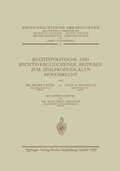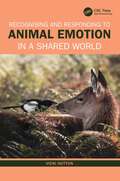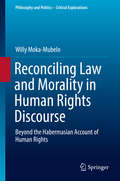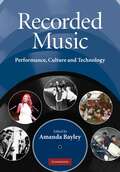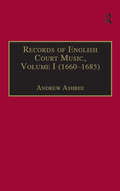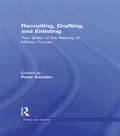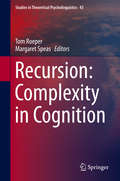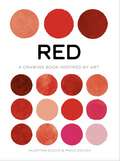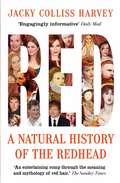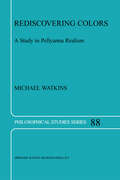- Table View
- List View
Rechtspolitische und Rechtsvergleichende Beiträge zum Zivilprozessualen Beweisrecht (Prozessrechtliche Abhandlungen)
by Helmut Rühl Char Fragistas N. Fritz AbrahamDieser Buchtitel ist Teil des Digitalisierungsprojekts Springer Book Archives mit Publikationen, die seit den Anfängen des Verlags von 1842 erschienen sind. Der Verlag stellt mit diesem Archiv Quellen für die historische wie auch die disziplingeschichtliche Forschung zur Verfügung, die jeweils im historischen Kontext betrachtet werden müssen. Dieser Titel erschien in der Zeit vor 1945 und wird daher in seiner zeittypischen politisch-ideologischen Ausrichtung vom Verlag nicht beworben.
Rechtspraxis in einer globalisierten Lebenswelt: Interkulturelle Kompetenz als Schlüsselqualifikation für Juristen
by Martina Weis-DalalInterkulturalität ist in sämtlichen Bereichen des alltäglichen Lebens zu einem Merkmal unserer Zeit geworden. Mit den sich hieraus ergebenden Herausforderungen sieht sich auch die deutsche Justiz zunehmend konfrontiert. Am Beispiel des Strafrechts gibt dieser Band Aufschluss darüber, in welchen Hinsichten Kultur in der Rechtspraxis von Bedeutung ist, welche Fähigkeiten interkulturelle Kompetenz in Rechtsprechung und Rechtsberatung ausmachen und stellt Konzepte vor, wie eine zukunftsweisende Juristenausbildung aussehen könnte, die der Vielfalt unserer globalisierten Lebenswelt Rechnung trägt.Die AutorinDie Kulturwissenschaftlerin und Pädagogin Martina Weis-Dalal war in den Jahren 2014 - 2020 als wissenschaftliche Mitarbeiterin an der Juristischen Fakultät der Universität Würzburg tätig, wo sie das interdisziplinäre Lehrprojekt „Globale Systeme und interkulturelle Kompetenz“ (GSiK) vertrat und zu Interkulturalität und Recht lehrte.
Reclaiming Fair Use: How to Put Balance Back in Copyright, Second Edition
by Patricia Aufderheide Peter JasziIn the increasingly complex and combative arena of copyright in the digital age, record companies sue college students over peer-to-peer music sharing, YouTube removes home movies because of a song playing in the background, and filmmakers are denied a distribution deal when a permissions i proves undottable. Analyzing the dampening effect that copyright law can have on scholarship and creativity, Patricia Aufderheide and Peter Jaszi urge us to embrace in response a principle embedded in copyright law itself—fair use. Originally published in 2011, Reclaiming Fair Use challenged the widely held notion that copyright law is obsolete in an age of digital technologies. Beginning with a survey of the contemporary landscape of copyright law, Aufderheide and Jaszi drew on their years of experience advising documentary filmmakers, English teachers, performing arts scholars, and other creative professionals to lay out in detail how the principles of fair-use can be employed to avoid copyright violation. Taking stock of the vibrant remix culture that has only burgeoned since the book’s original publication, this new edition addresses the expanded reach of fair use—tracking the Twitter hashtag #WTFU (where’s the fair use?), the maturing of the transformativeness measure in legal disputes, the ongoing fight against automatic detection software, and the progress and delays of digitization initiatives around the country. Full of no-nonsense advice and practical examples, Reclaiming Fair Use remains essential reading for anyone interested in law, creativity, and the ever-broadening realm of new media.
Reclaiming Fair Use: How to Put Balance Back in Copyright, Second Edition
by Patricia Aufderheide Peter JasziIn the increasingly complex and combative arena of copyright in the digital age, record companies sue college students over peer-to-peer music sharing, YouTube removes home movies because of a song playing in the background, and filmmakers are denied a distribution deal when a permissions i proves undottable. Analyzing the dampening effect that copyright law can have on scholarship and creativity, Patricia Aufderheide and Peter Jaszi urge us to embrace in response a principle embedded in copyright law itself—fair use. Originally published in 2011, Reclaiming Fair Use challenged the widely held notion that copyright law is obsolete in an age of digital technologies. Beginning with a survey of the contemporary landscape of copyright law, Aufderheide and Jaszi drew on their years of experience advising documentary filmmakers, English teachers, performing arts scholars, and other creative professionals to lay out in detail how the principles of fair-use can be employed to avoid copyright violation. Taking stock of the vibrant remix culture that has only burgeoned since the book’s original publication, this new edition addresses the expanded reach of fair use—tracking the Twitter hashtag #WTFU (where’s the fair use?), the maturing of the transformativeness measure in legal disputes, the ongoing fight against automatic detection software, and the progress and delays of digitization initiatives around the country. Full of no-nonsense advice and practical examples, Reclaiming Fair Use remains essential reading for anyone interested in law, creativity, and the ever-broadening realm of new media.
Reclaiming Fair Use: How to Put Balance Back in Copyright, Second Edition
by Patricia Aufderheide Peter JasziIn the increasingly complex and combative arena of copyright in the digital age, record companies sue college students over peer-to-peer music sharing, YouTube removes home movies because of a song playing in the background, and filmmakers are denied a distribution deal when a permissions i proves undottable. Analyzing the dampening effect that copyright law can have on scholarship and creativity, Patricia Aufderheide and Peter Jaszi urge us to embrace in response a principle embedded in copyright law itself—fair use. Originally published in 2011, Reclaiming Fair Use challenged the widely held notion that copyright law is obsolete in an age of digital technologies. Beginning with a survey of the contemporary landscape of copyright law, Aufderheide and Jaszi drew on their years of experience advising documentary filmmakers, English teachers, performing arts scholars, and other creative professionals to lay out in detail how the principles of fair-use can be employed to avoid copyright violation. Taking stock of the vibrant remix culture that has only burgeoned since the book’s original publication, this new edition addresses the expanded reach of fair use—tracking the Twitter hashtag #WTFU (where’s the fair use?), the maturing of the transformativeness measure in legal disputes, the ongoing fight against automatic detection software, and the progress and delays of digitization initiatives around the country. Full of no-nonsense advice and practical examples, Reclaiming Fair Use remains essential reading for anyone interested in law, creativity, and the ever-broadening realm of new media.
Reclaiming Fair Use: How to Put Balance Back in Copyright, Second Edition
by Patricia Aufderheide Peter JasziIn the increasingly complex and combative arena of copyright in the digital age, record companies sue college students over peer-to-peer music sharing, YouTube removes home movies because of a song playing in the background, and filmmakers are denied a distribution deal when a permissions i proves undottable. Analyzing the dampening effect that copyright law can have on scholarship and creativity, Patricia Aufderheide and Peter Jaszi urge us to embrace in response a principle embedded in copyright law itself—fair use. Originally published in 2011, Reclaiming Fair Use challenged the widely held notion that copyright law is obsolete in an age of digital technologies. Beginning with a survey of the contemporary landscape of copyright law, Aufderheide and Jaszi drew on their years of experience advising documentary filmmakers, English teachers, performing arts scholars, and other creative professionals to lay out in detail how the principles of fair-use can be employed to avoid copyright violation. Taking stock of the vibrant remix culture that has only burgeoned since the book’s original publication, this new edition addresses the expanded reach of fair use—tracking the Twitter hashtag #WTFU (where’s the fair use?), the maturing of the transformativeness measure in legal disputes, the ongoing fight against automatic detection software, and the progress and delays of digitization initiatives around the country. Full of no-nonsense advice and practical examples, Reclaiming Fair Use remains essential reading for anyone interested in law, creativity, and the ever-broadening realm of new media.
Recognising and Responding to Animal Emotion in a Shared World
by Vicki HuttonHow is it that depending on the setting, the same cat can be perceived as a homeless annoyance, a potential research subject or a thinking and feeling family member? The answer is bound up in our perception of non-human animals’ capacity to experience emotions, and this book draws on contemporary evidence-based research, observations, interviews and anecdotal case scenarios to explore the growing knowledge base around animal emotion. Acknowledging that animals can experience feelings directly affects the way that they are perceived and treated in many settings, and the author explores the implications when humans apply – or ignore – this knowledge selectively between species and within species. This information is presented within the unique context of a proposed hierarchy of perceived non-human animals' emotional abilities (often based on human interpretation of the animal’s emotional capacity), with examples of how this manifests at an emotional, spiritual and moral level. Implications for specific groups living with, caring for or working with non-human animals are examined, making the book of particular interest to those working, studying or researching in the veterinary professions; animal ethics, law and welfare; and zoology, biology and animal science. This book will also be fascinating reading for anyone interested in simply learning more about the animals with whom we share this planet. For some readers, it will validate the reciprocal emotional bond they feel for living creatures. For others, it will raise questions about the moral treatment of sentient non-human beings, breaking down the human protective barrier of cognitive dissonance and activating a cycle of change.
Recognising and Responding to Animal Emotion in a Shared World
by Vicki HuttonHow is it that depending on the setting, the same cat can be perceived as a homeless annoyance, a potential research subject or a thinking and feeling family member? The answer is bound up in our perception of non-human animals’ capacity to experience emotions, and this book draws on contemporary evidence-based research, observations, interviews and anecdotal case scenarios to explore the growing knowledge base around animal emotion. Acknowledging that animals can experience feelings directly affects the way that they are perceived and treated in many settings, and the author explores the implications when humans apply – or ignore – this knowledge selectively between species and within species. This information is presented within the unique context of a proposed hierarchy of perceived non-human animals' emotional abilities (often based on human interpretation of the animal’s emotional capacity), with examples of how this manifests at an emotional, spiritual and moral level. Implications for specific groups living with, caring for or working with non-human animals are examined, making the book of particular interest to those working, studying or researching in the veterinary professions; animal ethics, law and welfare; and zoology, biology and animal science. This book will also be fascinating reading for anyone interested in simply learning more about the animals with whom we share this planet. For some readers, it will validate the reciprocal emotional bond they feel for living creatures. For others, it will raise questions about the moral treatment of sentient non-human beings, breaking down the human protective barrier of cognitive dissonance and activating a cycle of change.
Recollections and Letters of General Lee
by Robert E. LeeBiography of the famous general by his son
Recollections and Letters of General Robert E. Lee
by Robert E. LeeGeneral Robert E. Lee was the most heroic figure of the Civil War, but to many, he is a solitary figure. This book fleshes out the man and reveals the workings of a great military mind and a warm, understanding, and generous human being. It shows all the facets of the general during the war; at the conclusion, when he was an outspoken proponent of a reasonable peace which would allow the South to rejoin the Union; and after the war, when he served as president of Washington College, and became a driving force for the creation of a viable educational system. This anthology shows all these facets of the general, through his correspondence and through the revealing insight supplied by his son. No other collection of source materials gives such a whole and rewarding picture of one of the South's greatest sons and heroes.
Reconciling Law and Morality in Human Rights Discourse: Beyond the Habermasian Account of Human Rights (Philosophy and Politics - Critical Explorations #3)
by Willy Moka-MubeloIn this book I argue for an approach that conceives human rights as both moral and legal rights. The merit of such an approach is its capacity to understand human rights more in terms of the kind of world free and reasonable beings would like to live in rather than simply in terms of what each individual is legally entitled to. While I acknowledge that every human being has the moral entitlement to be granted living conditions that are conducive to a dignified life, I maintain, at the same time, that the moral and legal aspects of human rights are complementary and should be given equal weight. The legal aspect compensates for the limitations of moral human rights the observance of which depends on the conscience of the individual, and the moral aspect tempers the mechanical and inhumane application of the law. Unlike the traditional or orthodox approach, which conceives human rights as rights that individuals have by virtue of their humanity, and the political or practical approach, which understands human rights as legal rights that are meant to limit the sovereignty of the state, the moral-legal approach reconciles law and morality in human rights discourse and underlines the importance of a legal framework that compensates for the deficiencies in the implementation of moral human rights. It not only challenges the exclusively negative approach to fundamental liberties but also emphasizes the necessity of an enforcement mechanism that helps those who are not morally motivated to refrain from violating the rights of others. Without the legal mechanism of enforcement, the understanding of human rights would be reduced to simply framing moral claims against injustices. From the moral-legal approach, the protection of human rights is understood as a common and shared responsibility. Such a responsibility goes beyond the boundaries of nation-states and requires the establishment of a cosmopolitan human rights regime based on the conviction that all human beings are members of a community of fate and that they share common values which transcend the limits of their individual states. In a cosmopolitan human rights regime, people are protected as persons and not as citizens of a particular state.
Reconfiguration of the Global South: Africa and Latin America and the 'Asian Century' (Europa Regional Perspectives)
by Eckart WoertzSince the 1980s there has been a steady shift from West to East in the international system, economically, politically and culturally. Emerging markets in Asia have moved up the value chain of industrial production processes, while the share of Western industrialized countries in global gross domestic product has declined. Countries such as China and India are asserting themselves in security matters and seeking new avenues for investment flows and development co-operation. China’s expected shift from export-led growth to domestic consumption might further change patterns of trade and capital flows, and it is an open debate whether the growth dynamics of India might outstrip those of China. While the rise of China and other Asian powers has been studied extensively, much less work has been done on how Africa and Latin America position themselves in this process. What will the role be of Africa and Latin America in the ‘Asian Century’ and associated reconfigurations of global value chains? Will these regions be able to assert themselves and find a voice of their own? Will they manage to develop industries of their own and diversify trade relations? Will they launch new ways of regional south-south co-operation? What is the role of migrant communities and cultural exchange? Do Western and Asian approaches to these regions differ (Washington vs. Beijing consensus)? This book brings together renowned academics from Africa, Latin America, Europe and the USA, who bring refreshing perspectives on an under-researched topic, ranging from a conceptualization of the issue within new theoretical approaches, to unique case studies based on field work.
Reconfiguration of the Global South: Africa and Latin America and the 'Asian Century' (Europa Regional Perspectives)
by Eckart WoertzSince the 1980s there has been a steady shift from West to East in the international system, economically, politically and culturally. Emerging markets in Asia have moved up the value chain of industrial production processes, while the share of Western industrialized countries in global gross domestic product has declined. Countries such as China and India are asserting themselves in security matters and seeking new avenues for investment flows and development co-operation. China’s expected shift from export-led growth to domestic consumption might further change patterns of trade and capital flows, and it is an open debate whether the growth dynamics of India might outstrip those of China. While the rise of China and other Asian powers has been studied extensively, much less work has been done on how Africa and Latin America position themselves in this process. What will the role be of Africa and Latin America in the ‘Asian Century’ and associated reconfigurations of global value chains? Will these regions be able to assert themselves and find a voice of their own? Will they manage to develop industries of their own and diversify trade relations? Will they launch new ways of regional south-south co-operation? What is the role of migrant communities and cultural exchange? Do Western and Asian approaches to these regions differ (Washington vs. Beijing consensus)? This book brings together renowned academics from Africa, Latin America, Europe and the USA, who bring refreshing perspectives on an under-researched topic, ranging from a conceptualization of the issue within new theoretical approaches, to unique case studies based on field work.
Reconsidering Constitutional Formation I National Sovereignty: A Comparative Analysis of the Juridification by Constitution (Studies in the History of Law and Justice #6)
by Ulrike MüßigThis open access book can be downloaded from link.springer.comLegal studies and consequently legal history focus on constitutional documents, believing in a nominalist autonomy of constitutional semantics. Reconsidering Constitutional Formation in the late 18th and 19th century, kept historic constitutions from being simply log-books for political experts through a functional approach to the interdependencies between constitution and public discourse. Sovereignty had to be ‘believed’ by the subjects and the political élites. Such a communicative orientation of constitutional processes became palpable in the ‘religious’ affinities of the constitutional preambles. They were held as ‘creeds’ of a new order, not only due to their occasional recourse to divine authority, but rather due to the claim for eternal validity contexts of constitutional guarantees. The communication dependency of constitutions was of less concern in terms of the preamble than the constituents’ big worries about government organisation. Their indecisiveness between monarchical and popular sovereignty was established through the discrediting of the Republic in the Jacobean reign of terror and the ‘renaissance’ of the monarchy in the military resistance against the French revolutionary and later Napoleonic campaigns. The constitutional formation as a legal act of constituting could therefore defend the monarchy from the threat of the people (Albertine Statute 1848), could be a legal decision of a national constituent assembly (Belgian Constitution 1831), could borrow from the old liberties (Polish May Constitution 1791) or try to remain in between by referring to the Nation as sovereign (French September Constitution 1791, Cádiz Constitution 1812). Common to all contexts is the use of national sovereignty as a legal starting point. The consequent differentiation between constituent and constituted power manages to justify the self-commitment of political power in legal terms. National sovereignty is the synonym for the juridification of sovereignty by means of the constitution. The novelty of the constitutions of the late 18th and 19th century is the normativity, the positivity of the constitutional law as one unified law, to be the measure for the legality of all other law. Therefore ReConFort will continue with the precedence of constitution. (www.reconfort.eu)
Reconsidering Constitutional Formation II Decisive Constitutional Normativity: From Old Liberties to New Precedence (Studies in the History of Law and Justice #12)
by Ulrike MüßigThis second volume of ReConFort, published open access, addresses the decisive role of constitutional normativity, and focuses on discourses concerning the legal role of constitutional norms. Taken together with ReConFort I (National Sovereignty), it calls for an innovative reassessment of constitutional history drawing on key categories to convey the legal nature of the constitution itself (national sovereignty, precedence, justiciability of power, judiciary as constituted power).In the late 18th and early 19th centuries, constitutional normativity began to complete the legal fixation of the entire political order. This juridification in one constitutional text resulted in a conceptual differentiation from ordinary law, which extends to alterability and justiciability. The early expressions of this ‘new order of the ages’ suggest an unprecedented and irremediable break with European legal tradition, be it with British colonial governance or the French ancien régime. In fact, while the shift to constitutions as a hierarchically ‘higher’ form of positive law was a revolutionary change, it also drew upon old liberties. The American constitutional discourse, which was itself heavily influenced by British common law, in turn served as an inspiration for a variety of constitutional experiments – from the French Revolution to Napoleon’s downfall, in the halls of the Frankfurt Assembly, on the road to a unified Italy, and in the later theoretical discourse of twentieth-century Austria. If the constitution states the legal rules for the law-making process, then its Kelsian primacy is mandatory.Also included in this volume are the French originals and English translations of two vital documents. The first – Emmanuel Joseph Sieyès’ Du Jury Constitutionnaire (1795) – highlights an early attempt to reconcile the democratic values of the French Revolution with the pragmatic need to legally protect the Revolution. The second – the 1812 draft of the Constitution of the Kingdom of Poland – presents the ‘constitutional propaganda’ of the Russian Tsar Alexander I to bargain for the support of the Lithuanian and Polish nobility. These documents open new avenues of research into Europe’s constitutional history: one replete with diverse contexts and national experiences, but above all an overarching motif of constitutional decisiveness that served to complete the juridification of sovereignty. (www.reconfort.eu)
Reconstructing Sovereignty (Law and Philosophy Library #132)
by Antonia M. WaltermannThe notion of sovereignty plays an important part in various areas of law, such as constitutional law and international public law. Though the concept of sovereignty as applied in constitutional law differs from that used in international public law, there is no true consensus on the meaning of “sovereignty” within these respective fields, either.Is sovereignty about factual power, or only about legal equality? Do only democracies have sovereignty, because they have legitimacy, or is there no (necessary) connection between democracy, legitimacy and sovereignty? Has the European Union encroached upon the sovereignty of the Member States, or is transferring competences to the European Union an expression and exercise of the very sovereignty some claim is under attack? Is it about states, or is it about peoples having a right to self-determination, and if the latter, does this represent popular sovereignty or something else? In order to answer these and related questions, we need a clear grasp of what “sovereignty” means. This book provides an analytical and conceptual framework for “sovereignty” in the context of law.The book does not seek to describe how the term “sovereignty” is used in the different contexts and discourses in which it is employed, but rather distinguishes between two possible meanings of sovereignty that allow the reader to use the term with specificity and clarity. In this way, this book hopes to offer valuable analytical tools for politicians, constitutional and international lawyers (both practitioners and academics) and legal theorists that help them be clear about what they mean when they speak of “sovereignty.”
Recorded Music (PDF): Performance, Culture And Technology
by Amanda BayleyResearch in the area of recorded music is becoming increasingly diverse. Contributions from a variety of fields, including music performance, composition and production, cultural studies and philosophy, are drawn together here, for the contrasting perspectives they bring to a range of music genres. Discourses in jazz, ethnomusicology and popular music - whose histories and practices have evolved principally from recordings - are presented alongside those of Western classical music, where analysis of recordings is a relatively recent development. Different methodologies have evolved in each of these subdisciplines where recordings have been contextualised variously as tools, texts, or processes, reflective of social practices. This book promotes the sharing of such differences of approach. Attitudes of performers are considered alongside developments in technology, changing listening practices, and social contexts, to explore the ways in which recordings influence the study of music performance and the nature of musical experience.
Records of English Court Music: Volume I (1660-1685)
by Andrew AshbeePioneering work on the musical material from the archives of the English court was undertaken by Nagel (1894), Lafontaine (1909) and Stokes (in the Musical Antiquary 1903-1913). Records of English Court Music (a series of seven volumes covering the period 1485-1714) is the first attempt to compile a systematic calendar of such references. It aims to revise these earlier studies where necessary, adding significant details which researchers omitted, clarifying the context of documents and substituting current call-marks for defunct references. Volume V is primarily concerned with the post-Restoration years already partially covered in volumes I and II. The material from the Exchequer and Declared Accounts of the Treasurer of the Chamber has been revised to include references to trumpeters and drummers. Other sections are devoted to material outside the Lord Chamberlain's papers: the Signet Office Docquet Books, Secret Service accounts and more from the Exchequer; the Corporation of Musick (controlled by the Court musicians) and to the range of music material from accounts of the Receivers General. Samples from the comprehensive records of the Lord Steward's department (including those of the Cofferer of the Household) are also provided. Andrew Ashbee was the winner of the Oldman Prize in 1987 for Volume II in the series of 'Records of English Court Music', awarded by the UK branch of the International Association of Music Libraries for the year's best book on music librarianship, bibliography and reference.
Records of English Court Music: Volume I (1660-1685)
by Andrew AshbeePioneering work on the musical material from the archives of the English court was undertaken by Nagel (1894), Lafontaine (1909) and Stokes (in the Musical Antiquary 1903-1913). Records of English Court Music (a series of seven volumes covering the period 1485-1714) is the first attempt to compile a systematic calendar of such references. It aims to revise these earlier studies where necessary, adding significant details which researchers omitted, clarifying the context of documents and substituting current call-marks for defunct references. Volume V is primarily concerned with the post-Restoration years already partially covered in volumes I and II. The material from the Exchequer and Declared Accounts of the Treasurer of the Chamber has been revised to include references to trumpeters and drummers. Other sections are devoted to material outside the Lord Chamberlain's papers: the Signet Office Docquet Books, Secret Service accounts and more from the Exchequer; the Corporation of Musick (controlled by the Court musicians) and to the range of music material from accounts of the Receivers General. Samples from the comprehensive records of the Lord Steward's department (including those of the Cofferer of the Household) are also provided. Andrew Ashbee was the winner of the Oldman Prize in 1987 for Volume II in the series of 'Records of English Court Music', awarded by the UK branch of the International Association of Music Libraries for the year's best book on music librarianship, bibliography and reference.
Recruiting, Drafting, and Enlisting: Two Sides of the Raising of Military Forces (Military and Society)
by Peter KarstenFirst Published in 1999. Routledge is an imprint of Taylor & Francis, an informa company.
Recruiting, Drafting, and Enlisting: Two Sides of the Raising of Military Forces (Military and Society #Vol. 1)
by Peter KarstenFirst Published in 1999. Routledge is an imprint of Taylor & Francis, an informa company.
Recursion: Complexity in Cognition (Studies in Theoretical Psycholinguistics #43)
by Tom Roeper Margaret SpeasThis volume focuses on recursion and reveals a host of new theoretical arguments, philosophical perspectives, formal representations and empirical evidence from parsing, acquisition and computer models, highlighting its central role in modern science. Noam Chomsky, whose work introduced recursion to linguistics and cognitive science and other leading researchers in the fields of philosophy, semantics, computer science and psycholinguistics in showing the profound reach of this concept into modern science. Recursion has been at the heart of generative grammar from the outset. Recent work in minimalism has put it at center-stage with a wide range of consequences across the intellectual landscape. The contributor to this volume both advance the field and provide a cross-sectional view of the place that recursion takes in modern science.
Red: A Drawing Book Inspired by Art (True Color)
by Paolo D'Altan Valentina ZucchiMany people crave a creative outlet, but more often than not, don't know where to start. In Red, Valentina Zucchi and Paolo d'Altan invite you to nurture your creativity and build your confidence by taking inspiration from modern works of art that celebrate the prince of colours, red.Discover the reds best-loved by artists – from Tyrian purple to crimson red – which have been used since prehistoric times to conjure up many things, from fire and danger to blood, love and passion. Throughout the book, Valentina and Paolo provide creative and fun prompts – many based on famous works of art – which will encourage you to draw or paint on the pages using various techniques. Packed with inspiration from the world's most celebrated artists, including Leonardo da Vinci, Rothko, Titian, Matisse and more, you will discover the many meanings of red and just some of the ways it can be used to express your creative passion.Red is a short course in unlocking your creative self – perfect for budding artists of all ages who are keen to try out different artistic techniques and materials and begin their artistic journey.
Red: A New York Times bestseller
by Jacky Colliss HarveyA New York Times bestsellerRed is the first book to explore the history of red hair and red-headedness throughout the world. More than just a book for redheads, Red is a fascinating social and cultural celebration of a rich and mysterious genetic quirk.With an obsessive fascination that is as contagious as it is compelling: the book explories red hair in the ancient world, the prejudice manifested against redheads across medieval Europe, and red hair during the Renaissance as both an indicator of Jewishness and the height of fashion in Protestant England, thanks to Elizabeth I.It also examines depictions of red hair in art and literature, looks at modern medicine and the genetic decoding of redheads, and considers red hair in contemporary culture, from advertising to 'gingerism' and bullying.
Rediscovering Colors: A Study in Pollyanna Realism (Philosophical Studies Series #88)
by M. WatkinsIn Rediscovering Colors: A Study in Pollyanna Realism, Michael Watkins endorses the Moorean view that colors are simple, non-reducible, properties of objects. Consequently, Watkins breaks from what has become the received view that either colors are reducible to certain properties of interest to science, or else nothing is really colored. What is novel about the work is that Watkins, unlike other Mooreans, takes seriously the metaphysics of colors. Consequently, Watkins provides an account of what colors are, how they are related to the physical properties on which they supervene, and how colors can be causally efficacious without the threat of causal overdetermination. Along the way, he provides novel accounts of normal conditions and non-human color properties. The book will be of interest to any metaphysician and philosopher of mind interested in colors and color perception.
